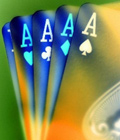玩游戏能帮助揭开蛋白质的秘密
Zoran Popovi?一看见这个头发,就知道眼前的这个人是David Baker。 这完全不会搞错:Baker是一头的卷发,而且还卷曲成那种不可预知的螺旋形,就和他所研究的那些复杂的蛋白质一个样。他俩以前没见过面,Popovi?是位于西雅图的华盛顿大学的一位图形学和电脑专家,而Baker一位生物化学家,其实验室在几个街区之外。Baker的一个朋友,同时也是一位电脑专家的David Salesin约了他俩一块在学校附近的一家餐馆吃饭,因为Baker需要有人帮他解决一个技巧性的问题——而这正是Popovi?所擅长的。
Baker是蛋白质化学界两年一次的世界范围大赛的MVP(最有价值选手),这个比赛是看谁能在仅仅知道一个蛋白质的组成部分(即氨基酸)序列的情况下,预测出它会折叠成什么形状。其全称是圈内蛋白质结构预测技术评估试验,缩写为CASP。
在一个叫做Rosetta@home工程的强大武器的帮助下,从1998年来,Baker的小组就在CASP中占据着优势。与SETI@home工程类似,这个屏保程序也是选择那些空闲的家用电脑,在空间上通过电波信号排好序,Rosetta则把计算任务分配给这些电脑志愿者。 分布在世界各地的86000台家用电脑合起来,能给Baker提供相当于一台77型万亿次浮点超级计算机的运算能力,用于参加CASP几周之后所举办的一个比赛。虽然Rosetta@home工程遇到了一些难题,不过Baker认为那些有着出众的空间推理能力的人将能很轻松地解决这些问题。
Baker建议用户需要通过一些途径去告诉屏保程序尝试不同的方法。但Popovi?却不这样想。“没人会去在乎这个的,”他说,“如果你真的想拉人进来,你就应该把他们放在中心位置。”
Salesin也是这么想的——实际上,他认为蛋白质的折叠可以做成一个很棒的电脑游戏。这也是为什么他要安排这顿饭的原因。而Baker想到了他那处于青春期的儿子玩视频游戏时脸上那种紧张专注的表情,欣然表示同意。
他们开发出来的游戏名叫Foldit,这款游戏不是旨在打怪升级,完成任务以及获取装备等。 它只是简单地提供五颜六色的螺旋和块构成的结点——用来组装蛋白质的三维结构。玩家们用光标沿着链长方向在任意位置上抓取、弯曲、拉伸和摆动氨基酸链,把蛋白质折叠成最合适的形状。唯一的要求是基于物理学规律——异性电荷相互吸引,旋转角度受原子间成的键所限制,蛋白质中带有水分子的部分趋向于露在外面等等。你所搭建的模型的性质越符合这些规则,你的得分就会越高。
从去年夏天以来,有超过10万的人下载了Foldit这个游戏,把游戏变成了多人参与的比赛——全球在线的分子快速折叠。而当他们给出可能正确的CASP蛋白质结构时,Baker就把这些参与到那个比赛中去。
一旦有人破解了蛋白质折叠中所隐藏的秘密,将进一步推动我们发现新的抗生素、治疗癌症的办法以及生物燃料等。Baker利用了人类的智慧和欲望,来代替仅仅依赖于电脑去推动他的研究。 那如果他的游戏玩家队伍中产生了几个专家怎么着呢?“那就更好了,”Baker说,“我们期盼着天才的加入。”
氢分子,是宇宙中最普通的分子,仅有两个原子构成,每个原子仅包含一个质子和一个电子。
蛋白质, 作为支撑从肌肉到母乳等很多东西的化学结构,则是位于复杂的那一头:由长长的卷曲的氨基酸分子骨架构成,每个蛋白质分子包含的原子数目能超过1万。
蛋白质的三维结构如何起作用是由它的原子相互作用的方式所决定的。想要把两个本来排斥的原子推的更近是不行的,这就像把两块磁石沿着错误的方向靠近一样。你可以强迫他们,但是大自然会选择那些阻力最小的构型。举个简单的例子,非常清楚的,水分子——H2O——是氢-氧-氢形成一个键角104.4度的V字形结构。这种推和拉是必然的,物理学注定了它。
译文:
As soon as Zoran Popovi? saw the hair, he knew he was looking at David Baker. It was unmistakable: Baker's face is surrounded by an umbra of curls that organize themselves into unpredictable spirals—not unlike the complex protein molecules he studies. They hadn't met before; Popovi? is an expert in graphics, a computer scientist at the University of Washington in Seattle, and Baker is a biochemistry professor with a laboratory a few blocks away. But David Salesin, another computer scientist and a friend of Baker's, had arranged for the three of them to meet for lunch in a restaurant near campus, because Baker needed help with a tricky problem—and it was exactly the kind of problem Popovi? was good at solving.
Baker was the Most Valuable Player in the protein chemistry world's biennial World Series, a competition to see who can predict the shape a protein will fold into, knowing nothing more than the sequence of its constituent parts. It's called the Community-Wide Experiment on the Critical Assessment of Techniques for Protein Structure Prediction, or CASP.
With the help of a formidable weapon called Rosetta@home, Baker's team had dominated CASP since 1998. Like SETI @home, the screensaver that taps spare home computer cycles to sort through radio signals from space, Rosetta farms out computation to volunteered PCs. The 86,000 computers around the world that run it would give Baker the rough equivalent of a 77-teraflop supercomputer for the November 2006 iteration of CASP a few weeks later. But Rosetta@home was getting stumped by puzzles that Baker thought humans, with their superior spatial reasoning, would solve easily.
Baker suggested that users should have some way to tell the screensaver to try a different approach. Popovi? shook his head. "No one's going to care about that," he said. "If you really want people to get engaged, you should put people at the center."Salesin thought so, too—in fact, he thought protein folding would make a terrific computer game. That's why he'd set up this lunch. Baker, thinking about the intense focus he'd seen on the face of his preteen son when playing videogames, agreed.
The game they came up with, Foldit, doesn't have orcs or quests or gravity hammers. It simply serves up a multicolored knot of spirals and clumps—a 3-D render of a protein. Players use the cursor to grab, bend, pull, and wiggle the chain of amino acids anywhere along its length, folding the protein into its optimum shape. The only rules are based on physics—opposite charges attract, atomic bonds have limited angles of rotation, and the parts of the molecule that stick to water tend to point outward. The closer your model's properties adhere to those rules, the more points you get.
More than 100,000 people have downloaded Foldit since last summer, turning the game into massively multiplayer competition—global online molecular speed origami. And when they came up with potentially accurate CASP protein structures, Baker entered those into the competition.
Whoever cracks the hidden secrets of protein folding will push us that much closer to new antibiotics, cancer treatments, and biofuels. Instead of relying solely on computer cycles to accelerate his research, Baker has harnessed neurons and the human urge to play. And if his army of gamers yields a few savants? So much the better, Baker says. "We're looking for prodigies."Hydrogen, the most common molecule in the universe, is just two atoms—each with one proton and one electron.
Proteins, the chemical structures that underpin everything from muscles to mothers' milk, are at the other end of the complexity scale: Built on long, kinky backbones of molecules called amino acids, proteins can comprise more than 10,000 atoms apiece.
The key to how any protein works is its three-dimensional shape, determined by all the ways its atoms interact. Trying to push two atoms closer when they want to repel is like holding magnets together when they're oriented the wrong way. You can force them, but nature prefers configurations that follow the path of least resistance. In a simple molecule, that path is pretty clear: Water—H2O—is hydrogen-oxygen-hydrogen balanced perfectly in a V-shape at a 104.4-degree angle. This push and pull is inevitable. Physics is destiny.
- 上一篇:儿童过度玩游戏或对关节健康不利
- 下一篇:家长们阻止孩子过度上网玩游戏
相关推荐
随机专题



 您现在的位置:
您现在的位置: 
 二十一点算牌法
二十一点算牌法 百家乐高手透露战胜百家乐五点
百家乐高手透露战胜百家乐五点 在线骰宝游戏如何赢钱 两条技巧要牢记
在线骰宝游戏如何赢钱 两条技巧要牢记 德州扑克新手必须掌握稳健的公式化打法
德州扑克新手必须掌握稳健的公式化打法


